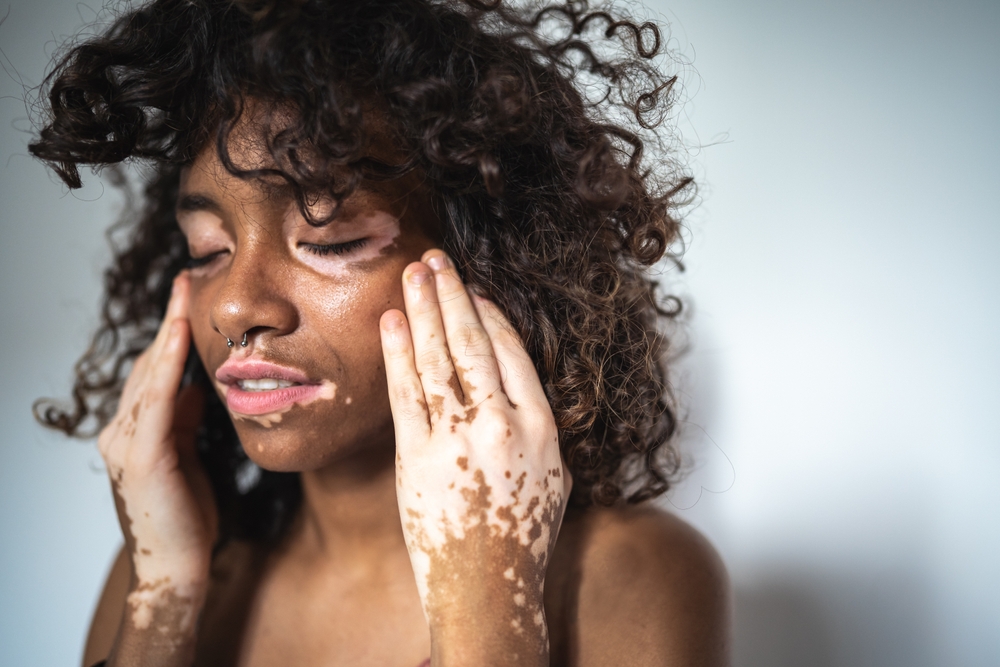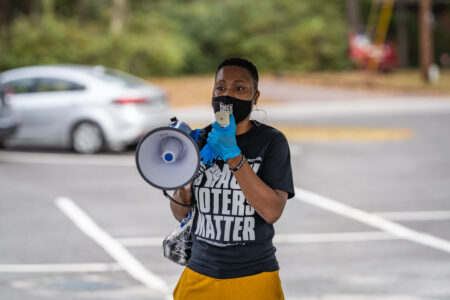Roughly ten years ago, many Americans didn’t know much about the effects of vitiligo but in recent years, big-name fashion models such as Tia Jonsson and Winnie Harlow, along with artistic athletes like principal ballerina Michaela DePrince were pioneers in changing that, helping to normalize it in the process. However, while they’ve made progress to heighten the public’s awareness and acceptance of vitiligo, unfortunately, there is still a long way to go.
Often referred to as an autoimmune skin disease that triggers the loss of skin color in patches and the premature whitening or graying of hair on the scalp, eyelashes, eyebrows or beards, vitiligo occurs when the body’s immune system destroys the pigment cells (or melanocytes) responsible for producing melanin, per the American Academy of Dermatology (AAD).
AAD also notes that while the cause is unclear, vitiligo typically appears around the eyes, face and hands but could also develop in more sensitive areas of the body, such as the mouth, scalp and groin. Although there are different versions of the disease that manifest in varying ways, they all show the inherent symptom of discoloration, ranging from localized to more widespread depigmentation on the body. Generalized vitiligo, the most common form, refers to discolored patches that present themselves symmetrically (matching spots on the left and right legs, for example). It tends to develop slowly, with new patches appearing periodically throughout a person’s life. Segmental vitiligo involves the rapid color loss of pigment on only one side of the body, with localized lesions that remain contained to just one or a few small areas. After about six months to a year, the color loss tends to stabilize with no development of new patches or spots.
Diagnosed in roughly 1% of the world’s population, this unique, incurable condition affects individuals of all skin types. Although the condition isn’t life-threatening, contagious and doesn’t cause any physical pain, its worst symptom might be the immeasurable stress inflicted by the persistently vicious social stigma that follows it. And for those with Black and brown skin especially, the grief can be downright debilitating.
Vitiligo’s Unequal Effect on Mental Health
Although doctors say vitiligo can be taxing on anyone with a diagnosis, research suggests those with darker skin tones tend to bear a greater societal burden. Not only is the disease often misdiagnosed or, in many cases, not diagnosed at all in some people of color (quite possibly contributing to why the percentage of confirmed cases is so low), but vitiligo imposes a more dire emotional and psychological toll for those with deeper-hued complexions because the light-to-dark color contrast is particularly visible. For them, the unsolicited attention, discrimination and bullying are excessive—more intense than for lighter-skinned patients (the depigmentation is less apparent)—which leads to low self-esteem, self-isolation and depression.
In his book, Turning White: A Memoir of Change, Black reporter and author Lee Thomas candidly describes how living with vitiligo was agonizing at times due to the horrifying reactions and unrelenting stares at the color of his skin. In an interview with NPR, he recounts an emotionally damaging incident where his appearance terribly frightened a little girl: “It was really traumatic for me because she really screamed,” he explained. “She was about three. And I stayed in the house for two weeks.”
Forty-two-year-old model and activist Iomikoe Johnson said she felt suicidal after her diagnosis with vitiligo at age 25. Her depression was fueled by cruel comments she’d receive from members of her own community in her Texas hometown. “At the start, I was scared about changing color. I have been a dark skin lady my whole life and then suddenly, my skin became white. It was scary,” she revealed to the Daily Mail. “There is nothing wrong with being white but that isn’t who I am. Every day, I am accused online of bleaching my skin and called names such as cow or Dalmatian.”
She added how distressing it was to endure such nasty remarks from those with whom she was most familiar; they believed she was intentionally mutilating her body out of self-hatred. “It hurts so bad when a comment comes from someone in my community—as a Black person, they should know how it feels to be discriminated against.”
Social beliefs can also negatively influence the quality of life for specific groups of individuals living with vitiligo, namely Black women. An article published by The Conversation—a leading reporter of research-based news—found that in Nigeria, some female patients experience discrimination from immediate family members, employers and the community at large, the religious beliefs oftentimes exacerbating the stigmas. For example, in some areas of the country, people believe that the disease is “God’s punishment” for their sins.

Getting Help for Vitiligo
Doctors say there are several ways for people of color to address the harrowing effects and shame that often accompany living with vitiligo. Seeking support from a psychodermatologist or other licensed mental health professionals can be extremely beneficial when experiencing feelings of anxiety, depression and low self-confidence, all of which are known to gravely affect individuals with the skin disorder, according to the American Journal of Clinical Dermatology. Doctors will listen to concerns and can offer a wide range of treatment options and therapies from topical remedies, light treatment, oral antiinflammatories, even surgery.
In addition, support groups from organizations such as Step Up for Vitiligo by the Global Vitiligo Foundation, the Vitiligo Research Foundation and Vitiligo Support International are great ways to connect with others who have vitiligo and to share information.
The Final Takeaway
While most of us may never encounter direct experiences with vitiligo, it doesn’t mean we shouldn’t make time to educate ourselves about how the emotional and psychological impact of the disease is painful on so many levels. Just like everyone else, people living with vitiligo want to be seen for more than their appearance, so as we continue to understand, discuss and normalize the condition, we all can move closer to a space where we feel accepted, totally comfortable in their skin because they know they are not alone – and are supported by “tribes” that care.








